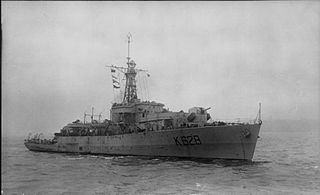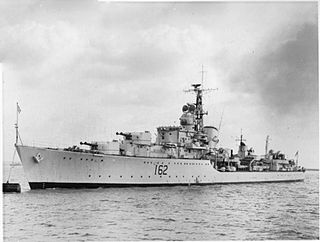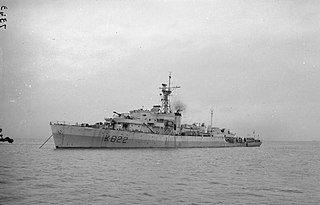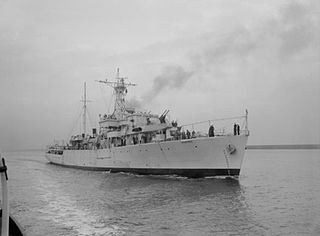
HMS Loch Killisport (K628/F628) was a Loch-class frigate of the British Royal Navy, named after Loch Killisport in Scotland. Launched in 1944, the ship was not commissioned until July 1945, and served in post-war repatriation operations in the Far East until decommissioned in April 1946. During this time Prince Philip was an officer on board this ship. Recommissioned in 1950 she served in the Home Fleet for two years, before being extensively modernised for service in the Persian Gulf and Far East. Decommissioned in August 1965, she was sold for scrapping in 1970.

HMS Loch Lomond was a Loch-class frigate of the British Royal Navy. The ship was named after Loch Lomond in Scotland.

HMS Jutland (D62) was a later or 1943 Battle-class fleet destroyer of the United Kingdom's Royal Navy. She was named after the Battle of Jutland, the largest naval battle of the First World War. The first Jutland was launched in 1945, but was cancelled that same year. Her sister ship, Malplaquet - named after a battle between Britain and France during the War of the Spanish Succession in 1709 - was renamed Jutland just prior to her launch on 20 February 1946, and was commissioned on 30 July 1947. The original Jutland was finally broken up in 1957 at Rosyth.

HMS Barrosa (D68) was a later or 1943 Battle-class fleet destroyer of the Royal Navy.

The Loch class was a class of anti-submarine (A/S) frigate built for the Royal Navy and her Allies during World War II. They were an innovative design based on the experience of three years of fighting in the Battle of the Atlantic and attendant technological advances. Some shipyards had trouble building these larger ships, which led to widespread use of the Castle-class corvette, introduced around the same time.

The Bay class was a class of 26 anti-aircraft (A/A) frigates built for the Royal Navy under the 1943 War Emergency Programme during World War II. They were based on the hulls of incomplete Loch class anti-submarine (A/S) frigates.

HMS Bigbury Bay was a Bay-class anti-aircraft frigate of the British Royal Navy, named for Bigbury Bay in Devon.
HMS Wigtown Bay was a Bay-class anti-aircraft frigate of the British Royal Navy. She was named for Wigtown Bay in Galloway.

HMS Burghead Bay was a Bay-class anti-aircraft frigate of the British Royal Navy, named for Burghead Bay in Morayshire.
HMS Enard Bay was a Bay-class anti-aircraft frigate of the British Royal Navy, named for Enard Bay in Caithness.
HMS Largo Bay was a Bay-class anti-aircraft frigate of the British Royal Navy, named for Largo Bay in Fife.
HMS St Austell Bay was a Bay-class anti-aircraft frigate of the British Royal Navy, named after St Austell Bay on the south coast of Cornwall. In commission from 1945 until 1956, she served in the Mediterranean Fleet and on the America and West Indies Squadron.
HMS St Brides Bay was a Bay-class anti-aircraft frigate of the British Royal Navy, named for St Brides Bay in Pembrokeshire. In commission from 1945 to 1961, she served in the Mediterranean and Eastern Fleets, seeing active service in the Korean War.
HMS Tremadoc Bay was a Bay-class anti-aircraft frigate of the British Royal Navy, named for Tremadoc Bay in north Wales.

HMS Veryan Bay was a Bay-class anti-aircraft frigate of the British Royal Navy, named after Veryan Bay on the south coast of Cornwall. In commission from 1945 until 1957, she saw service in the Pacific, Mediterranean, and Home Fleets, in the West Indies and in the South Atlantic.

HMS Whitesand Bay was a Bay-class anti-aircraft frigate of the British Royal Navy, named for Whitesand Bay in Cornwall. In commission from 1945 to 1954, she served in the Pacific, Mediterranean, West Indies and Far East Fleets, seeing active service in the Korean War.

HMS Widemouth Bay was a Bay-class anti-aircraft frigate of the Royal Navy, named for Widemouth Bay in Cornwall.

HMS Surprise was a Bay-class anti-aircraft frigate of the British Royal Navy. In commission from 1946 to 1965, she served in the Mediterranean Fleet as a Despatch Vessel for the Commander-in-Chief. Although principally employed for the use as a yacht by the CinC, Surprise was also deployed in its operational role as an anti-aircraft frigate and was allocated to the Haifa Patrol for a brief period in 1948. The archaic term "Despatch Vessel" was replaced by "Flag Frigate" in 1961.

HMS Mermaid was a Modified Black Swan-class sloop of the Royal Navy. Mermaid saw service as a convoy escort during the Second World War, taking part in the sinking of two German submarines while escorting Arctic convoys to and from the Soviet Union.

HMS Peacock was a modified Black Swan-class sloop of the Royal Navy. She was built for service as a convoy escort during the Second World War, serving in the arctic and Atlantic convoys. After the Second World War she saw service in the Mediterranean. She was scrapped in 1958.












